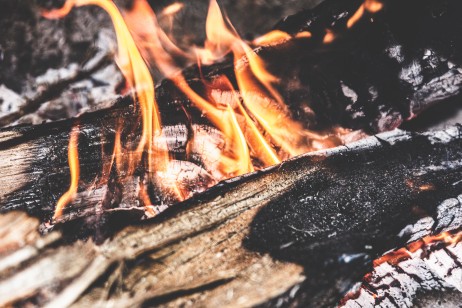
The Cold Within | The Poem
The Cold Within is a poem which seeks to hold a mirror against humanity reflecting how it has degenerated. Human beings have created many division among themselves like class, caste, race, religion, gender etc. The message of the poem is a simple one : if we keep discriminating each other, the world will surely end in chaos.
The Title of the poem is suggestive of all the negative attributes that human beings possess. The cold here is the resentment and ill-will which we bear towards others. These traits must be overcome or we shall be consumed by them just like the characters in the poem.
Got No Time? Check out this Quick Revision by Litbug on its Facebook Page. Follow the link below
https://m.facebook.com/Litbug.co/photos/a.353106305495706/848909935915338/?type=3&source=48
The Cold Within | Summary & Analysis
The Cold Within | Stanza 1
Six humans trapped by happenstance
In bleak and bitter cold.
Each one possessed a stick of wood
Or so the story’s told.
The poem begins with the narrator telling us about six humans who were trapped by coincidence (happenstance) in “a “bleak and bitter cold.” The cold, hopeless setting is instantly sketched by the use of the alliteration ‘bleak and bitter“. An important feature of the first stanza is the use of the term ‘humans’ (Six humans trapped) because that is what the six people are, first and foremost. Before they are the members of one race or the other, one creed or the other, they are human beings. They are human beings who have physical and emotional needs and who are susceptible to both hatred and cold. Unfortunately the failure on their part to recognize this basic fact becomes a cause of their doom.
Each one of them has a stick of wood. This wood isn’t merely a physical object but is symbolic of a resource or potential that all human beings possess. It is our willingness to use what we have for the sake of others that will keep the fire burning. The words or so the story’s told implies that the speaker has heard it from somewhere else which makes this a part of oral parables and folk wisdom.
The Cold Within | Stanza 2
Their dying fire in need of logs
The first man held his back.
For on the faces around the fire
He noticed one was black.
The fire was slowly dying out and was in need of firewood. However, the first person did not put his log into the fire because when he looked at his companions he noticed one of them was black. We will see how his racist attitude poisons the mind of his victim and how this racist attitude of his will backfire on him. This stanza brings to the fore a literary device of foreshadowing. The “dying fire” not only presents a particular condition but also foreshadows the fate of the characters. One moment it’s a dying fire and the other moment it’s people dying.
The Cold Within | Stanza 3
The next man looking across the way
Saw one not of his church
And couldn’t bring himself to give
The fire his stick of birch.
The next man looked around and saw that one person in the group did not belong to his church and he held back his stick of birch wood. He is a religious bigot, plain and simple and discriminates anybody who doesn’t share the same religious views as his.
The Cold Within | Stanza 4
The third one sat in tattered clothes.
He gave his coat a hitch.
Why should his log be put to use
To warm the idle rich?
The third person was poor man wearing torn and tattered as he was very poor. He pulled his coat to warm himself and thought why should he put his log into the fire to warm the lazy rich people. He too held back his firewood.
The Cold Within | Stanza 5
The rich man just sat back and thought
Of the wealth he had in store
And how to keep what he had earned
From the lazy shiftless poor.
The fourth was a rich man and thought only of his wealth he had accumulated and of how might he keep his riches away from the hands of the lazy and idle poor. As a result of his mistrust and prejudice, he too held back his firewood . It is interesting to see that both the rich and the poor keep their firewood to themselves due to the same underlying prejudice : both consider each other to be lazy and idle folks. Perhaps both are wrong. These stanzas show how prejudices develop when people are isolated from others who do not belong to the same racial, economic or religious group that they belong to.
The Cold Within | Stanza 6
The black man’s face spoke revenge
As the fire passed from his sight.
For all he saw in his stick of wood
Was a chance to spite the white.
The fifth person was a man with dark skin and all he thought was of taking a revenge on all the wrongs done to him. All he saw in his stick of wood was a chance to exact revenge upon the white skinned man. Being the victim of racial discrimination, he has decided to give the white guy a taste of his own medicine, even if it translates to him dying as well. He had internalized the discriminatory logic of the system which is effectively captured by the internal rhyme :
For all he saw in his stick of wood
Was a chance to spite the white.
All the characters in the story use their firewood as a tool of retribution and end up becoming a victim of their own hatred.
The Cold Within | Stanza 7
The last man of this forlorn group
Did nought except for gain.
Giving only to those who gave
Was how he played the game.
The last person of the group did nothing except for profit. He believed only in giving to those who gave something back to him. This was the way he played the game of life. So he too did not part with his stick as no one else had.
The selfishness of the sixth man is also the part of a larger problem. Everybody in this poem seem to “give only to those” who give them social approval by belonging to the same class creed or colour.
The Cold Within | Stanza 8
Their logs held tight in death’s still hands
Was proof of human sin.
They didn’t die from the cold without
They died from the cold within.
The entire group perishes in the end, all holding their fire sticks. They have failed to be of use to each other due to their inherent prejudices. They refuse to acknowledge each other’s humanity and in doing so they die despite having the resources to keep themselves alive.
A personification (death’s still hands) is used to highlight the consequences of committing this sin against humanity. They kill each other through inaction. This inaction is the product of the cold hatred they have against a single person (not everyone) in the group. And in the malevolent process of killing others, they end up killing themselves.
The conflict in the story is both external and internal in nature and may be seen in relation to two components of the poem. The characters are in conflict with their external environment (the cold) and at the same time by being pitted against each other and refusing to use their wood. This external conflict reaches resolution in the death of all.
The poem ends by stating that the reason behind their death wasn’t the cold outside but the cold hatred and prejudice they had in their hearts. A cool heart soon becomes a dead heart and a dead heart is always a cold one.
The cold, the fire and the stick of wood have dual significance in the poem. Literally, the cold outside is a harbinger of death, the fire is its antithesis and stands for possibility of life and the sticks they have is a resource to keep the fire burning. Symbolically, the cold within represents hatred and selfishness, the fire represents love and common good and the firewood they hold is symbolic of the prejudice they have against each other. They must let go their sticks of prejudice and let it burn in the fire of love and fellow feeling if they are to ward off the cold, a harbinger of death and keep the fire of life burning. However, because they cannot overcome the hatred and apathy (the cold within), they fail to let go their prejudice and everybody dies, holding their wood of prejudice.
The characters in the poem see the differences between them instead of the similarities. These assumed differences result in hatred of the other person thereby ensuring mutual destruction.
The poet urges all of us to examine the stick of wood that we have with us and throw it into the fire. Our mutual acknowledgement and appreciation of each other’s humanity, transcending the narrow confines of class, caste, creed and color is the only way humanity has can keep the fire burning. And with increasing polarization of modern society precisely along those fault lines, it might as well be our last chance to protect the dying fire.
The Cold Within | About the Author
James Patrick Kinney was born on 15th January 1932 in Cleveland, Ohio. He spent ten years at the Saint Charles Seminary in Ohio following which he decided to join the military. Kinney studied the Burmese language at the Defence Language Institute in Montery before taking up a position in Okinawa, Burma. Following his military service he worked as a teacher, a profession which helped him stay in touch with his interest of writing and storytelling. Kinney has written a couple of poems which reflect his positive credo towards life. Some of these poems include The Cold Within, The Secret of Life and A Better World among others.
James Kinney suffered a massive heart attack in 1948 which was followed by a number of strokes. He had to give up his career and was forced more than eight final years of his life at Monterey Care Centre.
He passed away on 12th August 2007.




its a nice summary
The explanation was very good and it helped me a lot in doing my project work.
Woahhhh that’s crazy how is the summary so good.
Thank you for the wonderful explanation of The Cold Within